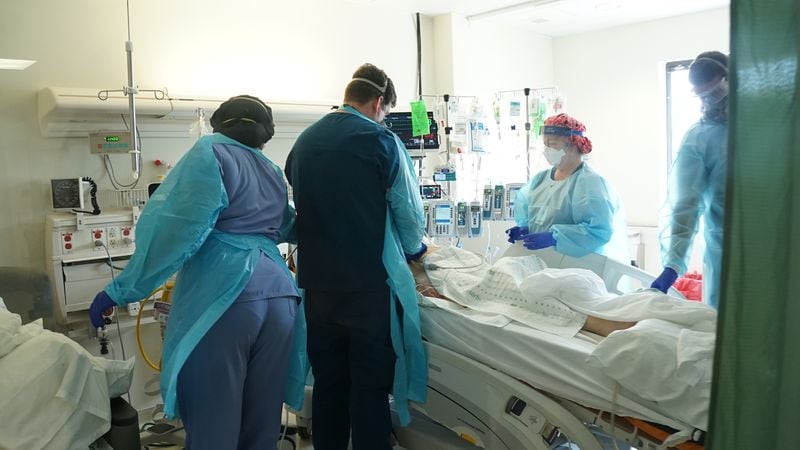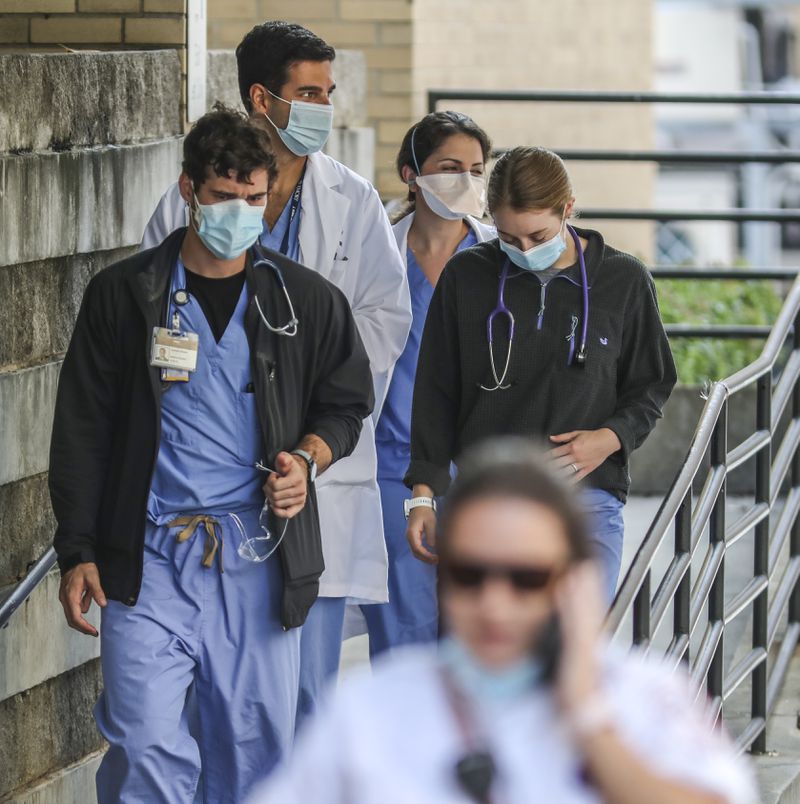Back in January, when “code blues” sounded relentlessly to summon teams for medical emergencies and morgues deployed mobile units for extra space to store bodies, Georgia got a reprieve. Cases soon plunged as holiday travel ended and many of the elderly became vaccinated.
This time, with vaccination rates stubbornly low and the highly contagious delta variant pervasive, hospitals expect the trendline to keep climbing well into September. As the numbers swell, hospital beds are being filled with younger, unvaccinated adults as well as children. On Tuesday, the state reported that hospitals had 5,656 COVID patients, about 50 patients below the January peak of 5,709. But at some hours in recent days, according to the Georgia Hospital Association, the number has topped 5,900.
That is forcing hospitals to make difficult decisions about how to care for patients when there aren’t enough beds or staff.
“I don’t mean to sound super doomsday-ish, but I think that if this growth continues, that we’re going to be risking regional hospital system collapse,” said Amber Schmidtke, a health care data researcher, who tracks Georgia’s COVID-19 trends.
Schmidtke said she doesn’t use the word “collapse” lightly.
“I know that that will scare people,” Schmidtke said. “But I think that that is what we’re risking. I’ve had M.D.s that are on the ground tell me the same thing: ‘This is unsustainable. We’re already at a point where we’re having to sort of triage care and decide who gets what based on limited resources and personnel.’”
The coming days could bring further delays in care for people sickened with COVID-19 or with other medical emergencies. Atlanta’s large children’s hospitals at times were so packed Tuesday that they were limiting transfers from other hospitals. ICUs are full at many hospitals, creating risks for all those who have to wait for a critical care bed, whether they have COVID or not. A critical nursing shortage means adding more beds in some hospitals will be pointless: There aren’t any more nurses available to staff them. It’s already hard or impossible to transfer patients from small hospitals to larger ones that can provide advanced care.
That has resulted in shortages of oxygen in recent days at some of the state’s rural hospitals, as they had to treat COVID-19 patients short of breath instead of transferring them. The shortage prompted Gov. Brian Kemp on Monday to loosen regulations for shipping compressed oxygen amid supply shortages.
“I don’t mean to sound super doomsday-ish, but I think that if this growth continues, that we’re going to be risking regional hospital system collapse.”
– Amber Schmidtke, a health care data researcher
Doctors and nurses have pleaded with Georgians to get vaccinated to protect their families, save their own lives and prevent the state’s healthcare system from becoming overwhelmed to the point of dysfunction. Yet almost all COVID-19 patients who are sick enough to reach the ICU or die are unvaccinated.
‘A very tenuous situation’
South Georgia’s hospitals close to the border of hard-hit Florida were the first to be overwhelmed with patients in this recent surge. Some set new records days ago for their number of COVID-19 patients.
Phoebe Putney Health System, based in Albany in southwestern Georgia made international headlines in spring 2020 as it handled what was for a time one of the most intense outbreaks on the globe.
This wave is worse.
Phoebe Putney has surpassed all its previous records, forcing it to once again take over other hospital space to create two additional intensive care units. Employees across the system are picking up duties wherever they can to free up clinically trained staff. The CEO has logged time in the ICU as a gofer, stocking supplies, helping bag trash, running specimens to the lab, gowning and escorting family members to visit patients.

Staff at Phoebe Putney Memorial Hospital in Albany care for a patient on the COVID-19 unit in this undated photo. The hospital made international headlines in spring 2020 as it handled what was for a time one of the most intense outbreaks on the globe. In this wave, what the hospital has handled is worse. (Photo courtesy of Phoebe Putney)
Helicopter teams stand ready to transfer patients out to lighten the load. But other hospitals can’t take them, either.
“So we’re taking care of the patients here,” said Dr. James Black, Phoebe’s medical director of emergency medicine. “We’re creating and opening new wings and ICUs as staffing and space permit.”
Where there’s no space or staff, patients wait, overflowing.
People no longer seem afraid of approaching the hospital for non-COVID-19 ailments, so the emergency room is swamped with them, too. It is housing in ER beds patients who should be admitted but for whom there are no inpatient beds. “It’s a very tenuous situation,” he said.
Black said he likes to keep the ratio of patients to ER doctors at around 12 to 14 patients per physician. Now, it’s going as high as 18 or 20.
“And the problem is, there’s not a good mixture of some that are real sick and some that are not so sick,” he said. Those taken back for ER treatment are almost all “extremely ill.”
“So it tests your limits, obviously,” he said, “of what you’re able to manage effectively.”
A bigger, more intense surge
While Phoebe Putney’s staff has already been dealing with its largest volume ever of COVID-19 patients, the rest of the hospitals in Georgia are preparing to do the same— if they haven’t already broken their pandemic records.
Already, metro Atlanta hospitals are over capacity, deluged by patients and short of staff. As non-COVID patients also continue to seek care, these hospitals in north metro Atlanta’s region “D” have already surpassed their overall peak patient numbers from January. With COVID-19 numbers continuing to grow, it’s unclear what will unfold inside. What’s already there is troubling.

Medical workers move between buildings at Grady Memorial Hospital in downtown Atlanta last week. Already, metro Atlanta hospitals are over capacity, deluged by patients and short of staff. (PHOTO by John Spink / John.Spink@ajc.com)
Credit: JOHN SPINK / AJC
Credit: JOHN SPINK / AJC
Since the delta variant surged, Wellstar Kennestone Hospital, even as it overflows with patients, has regularly shut down sections of its emergency room simply for lack of staff, clinical workers said. Piedmont Healthcare paused elective surgeries at some of its hospitals because of crowding and braced for what is coming.
“Increasingly we are now seeing younger patients in our hospitals,” said Dr. Andy Jaffal, chief medical officer at Piedmont Atlanta Hospital, at a press conference in August. “Those patients are getting sicker much sooner, they are on the ventilator much quicker. I watched a 28-year-old previously healthy, unvaccinated patient die from COVID complications.”
Even metro Atlanta’s largest hospitals have routinely resorted to diverting ambulance traffic because their ERs and ICUs are so full.
On maps showing hospital capacity, Atlanta is part of broad, dark swaths of the state stretching border to border—from Florida to the north Georgia mountains, and from Alabama to South Carolina—with hospitals crowded by COVID-19.
“We can already see in some ways that this surge is bigger and more intense — it’s faster — than what we saw with previous surges that had a little bit of a slow build. This one has taken off very quickly,” Schmidtke said.
She said she was particularly concerned about what effect school reopenings may be having on the surge in hospitalizations. Schools across the state have recently come back in person, and reports of infection clusters are widespread. The worst of them may hit hospitals about three to five weeks after initial spread.
“It remains to be seen how big of a driver of cases that will be,” Schmidtke said. “Unlike a young adult who may be able to go home and quarantine on their own, these kids are part of families; their infection doesn’t stop with them.”
Children’s Healthcare of Atlanta on Tuesday morning went on diversion for some ambulances seeking to transfer children from another hospital. Officials said that was because the system’s pediatric ICU attending physicians were evaluating transfer requests before accepting children from an outside hospital. The officials also said that their emergency departments were dealing with “extremely high volumes” due to COVID-19 and other respiratory viruses, though the departments were still accepting all emergency cases.
As of Tuesday, the hospitals had 34 patients with active COVID-19 cases and 25 more patients continuing to receive care for COVID-19 related conditions.
At Northeast Georgia Health System, Dr. John Delzell already lived through a surge in January that tested the Gainesville-based system’s limits. The system set up beds in its gym. Patients were in hallways, and doctors went out to the ambulance bays to triage patients since there wasn’t space to immediately bring them inside. On its peak day in the January surge, the system’s hospitals and other medical facilities took care of 355 COVID-19 patients.
NGHS expects to surpass that number in the weeks to come.
“The good that came out of January is that people know that we can take care of a lot more patients than we thought we could,” Delzell said. “But I do know people are really tired, and they’re tired of this. There is probably more frustration now because this feels more preventable at this point. In January, we couldn’t do anything about it. Now, it’s happening because people aren’t getting vaccinated.”
Delzell, vice president and incident commander for the system, said its emergency departments are already seeing record numbers of patients. Urgent care clinics are packed, too. “I don’t expect we’re going to slow down anytime soon,” he said.
The system is looking at every possible place it could add beds, knowing they will need more space than they did last time. It’s tapping into its staff to see how people can be shifted from what they normally do to caring for all the patients coming in, or helping support those who are providing the care. Delzell says that somehow the health system will find a way to get through the coming weeks.
“We are the hospital for this area and our commitment is to take care of all the patients in our community,” Delzell said. “The reality is there is no place else for them to go.”